Related Research Articles
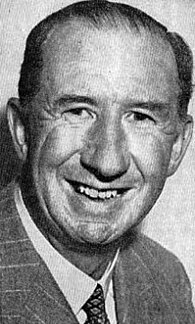
Nevil Shute Norway was an English novelist and aeronautical engineer who spent his later years in Australia. He used his full name in his engineering career and Nevil Shute as his pen name to protect his engineering career from inferences by his employers (Vickers) or fellow engineers that he was not a serious person or from potentially adverse publicity in connection with his novels, which included On the Beach and A Town Like Alice.
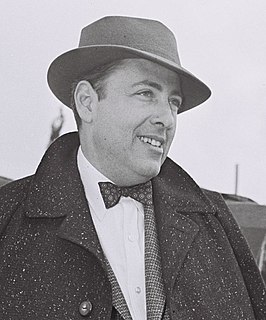
Herman Wouk was an American author best known for historical fiction such as The Caine Mutiny (1951) which won the Pulitzer Prize.
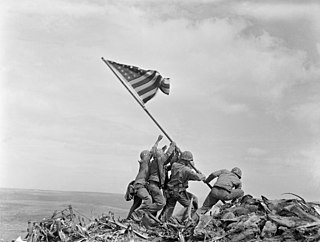
Raising the Flag on Iwo Jima is an iconic photograph of six United States Marines raising the U.S. flag atop Mount Suribachi during the Battle of Iwo Jima in the final stages of the Pacific War. The photograph, taken by Joe Rosenthal of the Associated Press on February 23, 1945, was first published in Sunday newspapers two days later and reprinted in thousands of publications. It was the only photograph to win the Pulitzer Prize for Photography in the same year as its publication, and was later used for the construction of the Marine Corps War Memorial in 1954, which was dedicated to honor all Marines who died in service since 1775. The memorial, sculpted by Felix de Weldon, is located in Arlington Ridge Park, near the Ord-Weitzel Gate to Arlington National Cemetery and the Netherlands Carillon. The photograph has come to be regarded in the United States as one of the most significant and recognizable images of World War II.
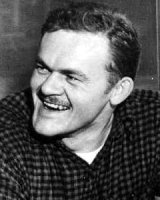
James Ramon Jones was an American novelist known for his explorations of World War II and its aftermath. He won the 1952 National Book Award for his first published novel, From Here to Eternity, which was adapted for the big screen immediately and made into a television series a generation later.

Forrest Meredith Tucker was an American actor in both movies and television who appeared in nearly a hundred films. Tucker worked as a vaudeville straight man at the age of only fifteen years old. A mentor provided funds and contacts for a trip to California, where party hostess Cobina Wright persuaded guest Wesley Ruggles to give Tucker a screen test because of Tucker's photogenic good looks, thick wavy hair and height of six feet, five inches. Tucker was a sight reader who needed only one take and his film career started well despite a perception in most Hollywood studios that blond men were not photogenic. He enlisted in the Army during World War II. After twenty years spent mainly in Westerns and action roles, he returned to his roots, showing versatility as a comedic and stage musical actor. In the television series F Troop, he became identified with the character of Cavalry Sgt. Morgan O'Rourke. Tucker struggled with a drinking problem that began to affect his performances in the later years of his career.
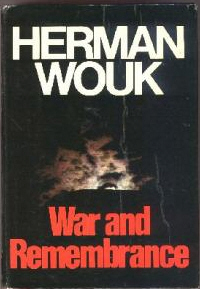
War and Remembrance is a novel by Herman Wouk, published in October 1978 as the sequel to Wouk's The Winds of War (1971). The Winds of War covers the period 1939 to 1941, and War and Remembrance continues the story of the extended Henry and Jastrow families from 15 December 1941 through 6 August 1945. The novel was adapted into a television mini-series, War and Remembrance, and presented on American television in 1988. Wouk was a screenwriter for the miniseries as well as being author of the book.
Harry Peter McNab Brown Jr. was an American poet, novelist and screenwriter.

USS Cotten (DD-669) was a Fletcher-class destroyer of the United States Navy, named for Captain Lyman A. Cotten (1874–1926).

Ferdy Mayne was a German-British stage and screen actor. Born in Mainz, he emigrated to the United Kingdom in the early 1930s to escape the Nazi regime. He resided in the UK for the majority of his professional career. He was best known as a character actor, often portraying aristocratic villains and eccentrics in films like The Fearless Vampire Killers, Where Eagles Dare, Barry Lyndon, and Benefit of the Doubt.
This is a list of bestselling novels in the United States in the 1950s, as determined by Publishers Weekly. The list features the most popular novels of each year from 1950 through 1959.
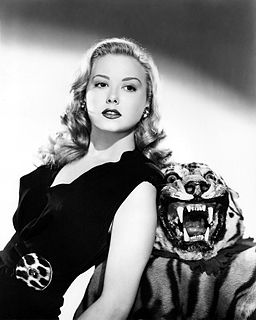
Adele Mara was an American actress, singer, and dancer, who appeared in films during the 1940s and 1950s and on television in the 1950s and 1960s. During the 1940s, the blonde actress was also a popular pinup girl.
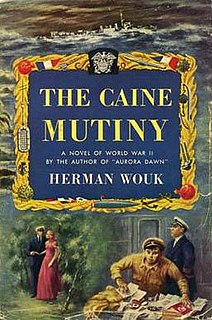
The Caine Mutiny is the 1951 Pulitzer Prize-winning novel by Herman Wouk. The novel grew out of Wouk's personal experiences aboard two destroyer-minesweepers in the Pacific Theater in World War II. Among its themes, it deals with the moral and ethical decisions made at sea by ship captains. The mutiny of the title is legalistic, not violent, and takes place during Typhoon Cobra, in December 1944. The court-martial that results provides the dramatic climax to the plot.

USS Logan (APA-196) was a Haskell-class attack transport of the United States Navy, named for counties in Colorado, Illinois, Kansas, Kentucky, Ohio, Oklahoma, Nebraska, North Dakota, and West Virginia. The Haskell-class design, Maritime Commission standard type VC2-S-AP5, is a sub type of the World War II Victory ship design.
Fred Graham was an American actor and stuntman, who performed in scores of films from the 1930s. A semiprofessional baseball player, Graham appeared mainly in Westerns, performing stunts and playing opposite John Wayne, among others. He also featured alongside Wayne in several films with director John Ford. He played small roles in two Alfred Hitchcock films, notably Vertigo, as the Police Officer who falls to his death in its famous opening scene while trying to help James Stewart. He continued working in films until the 1970s.

Letters from Iwo Jima is a 2006 Japanese-language American war film directed and co-produced by Clint Eastwood, starring Ken Watanabe and Kazunari Ninomiya. The film portrays the Battle of Iwo Jima from the perspective of the Japanese soldiers and is a companion piece to Eastwood's Flags of Our Fathers, which depicts the same battle from the American viewpoint; the two films were shot back to back. Letters from Iwo Jima is almost entirely in Japanese, despite being produced by American companies DreamWorks Pictures, Malpaso Productions and Amblin Entertainment. After Flags of Our Fathers flopped at the box office, Paramount Pictures sold the U.S. distribution rights to Warner Bros. Pictures.
There is a wide range of ways in which people have represented World War II in popular culture. Many works were created during the years of conflict and many more have arisen from that period of world history.
The following is a list of pop culture references to war.
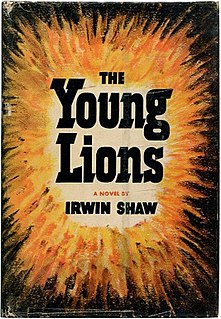
The Young Lions (1948) is a novel by Irwin Shaw about three soldiers in World War II.
Martin Yarus, better known by the stage name George Tyne, was an American stage and film actor and television director. He was blacklisted in the 1950s, and was indicted for contempt of Congress but subsequently acquitted.